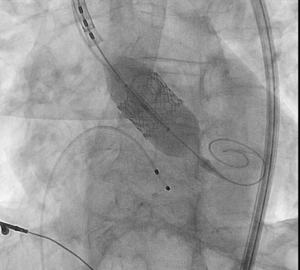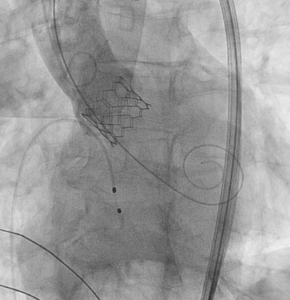Transcatheter Aortic Valve Replacement (TAVR): A Minimally Invasive Option for Aortic Stenosis
Aortic stenosis is one of the most common heart valve diseases, affecting one out of eight people over the age of 75. If you leave it untreated, severe cases can lead to heart failure, stroke, or even sudden cardiac death. Previously, open-heart surgery was the only option you had available to you for valve replacement. However, for many patients, this was not a viable choice. Transcatheter aortic valve replacement (TAVR) has transformed treatment, offering a minimally invasive alternative that reduces recovery time and improves your quality of life.
What Is Transcatheter Aortic Valve Replacement (TAVR)?
TAVR is a minimally invasive procedure our team uses to replace a diseased aortic valve without the need for open-heart surgery. During the procedure, we insert a new valve through a catheter that is typically placed in a blood vessel in the groin. Then, we guide it to your heart. Once in position, the new valve expands, pushing aside the damaged valve and restoring normal blood flow.
Because TAVR doesn’t require a chest incision or the use of a heart-lung machine, it is a great alternative for older patients or if you have other medical conditions that make traditional surgery too risky.
Why Is TAVR Performed?
TAVR is used to treat aortic stenosis, a condition where the aortic valve becomes narrowed due to calcium buildup, making it difficult for blood to flow from the heart to the rest of your body. Over time, this can cause:
- Shortness of breath
- Chest pain or pressure
- Dizziness or fainting
- Fatigue and reduced exercise capacity
Without treatment, severe aortic stenosis has a survival rate of 50% at two years. TAVR helps restore normal valve function, reducing symptoms and lowering the risk of complications.
Who Is a Candidate for TAVR?
TAVR was initially approved for patients who were classified as high risk for open-heart surgery, but advancements in the procedure have expanded its availability to patients in all risk categories. You may be a candidate if:
- You have severe symptomatic aortic stenosis.
- Open-heart surgery is too risky due to your age or some other medical conditions.
- You previously had a biological tissue valve that needs replacement.
How Is TAVR Performed?
We typically perform TAVR under conscious sedation or general anesthesia, depending on your needs. The procedure follows these steps:
- Catheter insertion: We make a small incision in your groin, called the transfemoral approach, or another access point.
- Valve placement: Next, we guide the replacement valve through the catheter to your aortic valve.
- Deployment: The new valve expands, securing it in place and pushing the old valve aside.
- Final adjustments: Our team verifies proper positioning before removing the catheter.
The procedure usually takes about an hour, and you can usually start walking within a few hours.
Are There Any Risks?
While TAVR is safer than open-heart surgery, there are still risks, including:
- Bleeding or vascular complications
- Heart rhythm disturbances requiring a pacemaker
- Valve leakage
- Stroke
The risk of major complications is low, and advances in technology continue to improve outcomes.
What Is Recovery Like?
TAVR patients recover faster than those undergoing open-heart surgery. You can expect to be discharged within 24–48 hours and get back to normal activities within a week or two. Make sure to:
- Follow your medication plan.
- Monitor for signs of infection or complications.
- Attend all follow-up appointments to check valve function.
- Maintain a heart-healthy lifestyle with regular exercise and a balanced diet.
Personalized Care at Hunterdon Cardiovascular Associates
At Hunterdon Cardiovascular Associates, we specialize in advanced treatments for heart valve disease, including TAVR. Our Valve Center, led by Dr. Venkatesh Alapati, provides comprehensive evaluations and tailored treatment plans to provide you with the best possible outcomes. Our offices in Flemington, Clinton, and Bridgewater offer convenient access to expert cardiovascular care. If you have aortic stenosis and want to explore your treatment options, contact Hunterdon Cardiovascular Associates today to schedule an appointment.





